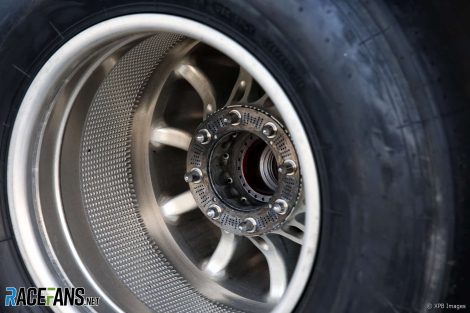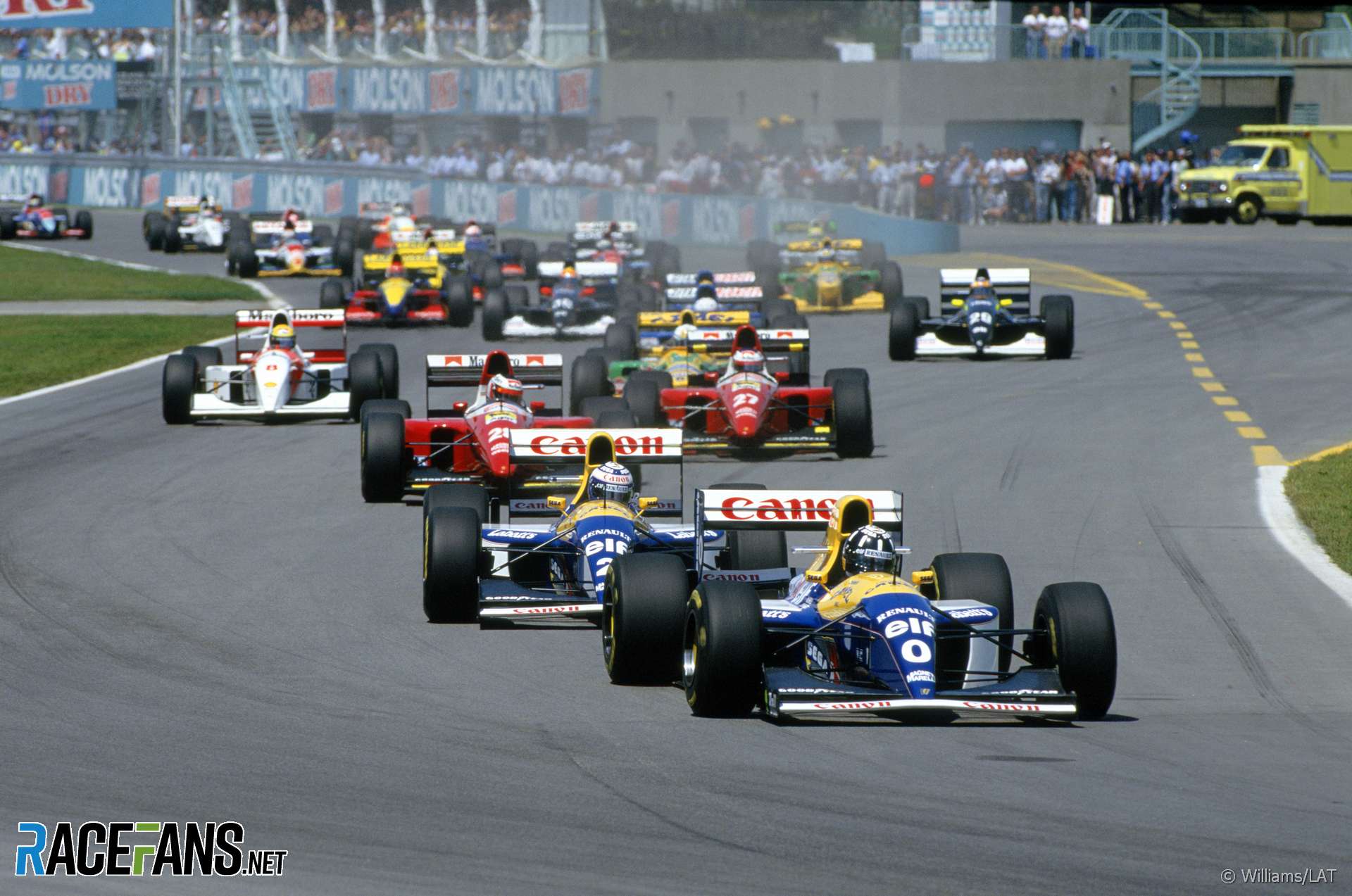Mercedes’ controversial rear wheel design is considered legal because of a precedent which was established in 1993 when Formula 1 cars last used active suspension.
Last week the team successfully petitioned the Mexican Grand Prix stewards to rule that key parts of the wheel’s design, including the use of spacers to improve heat transfer from the wheels, are legal.The dispute over the legality of the design centres on whether the holes in the wheel have an aerodynamic effect. If so, the wheels could be considered a moveable aerodynamic device. These are illegal, with certain specific exceptions (such as the Drag Reductions System).
The stewards ruled that the size of the holes is sufficiently small that they considered their primary function is cooling, rather than aerodynamics, and is therefore legal. However, they noted: “we would reserve [the] right to judge alternative geometries, and to change this view if (for example) the spacer were to grow beyond its primary function (that of a spacer) and if the holes were to become big enough to have a more significant aerodynamic effect.”
FIA race director Charlie Whiting explained this reasoning in response to a question from RaceFans.
“It all goes back to the World Council decision of 1993 on active suspension,” said Whiting. Active suspension systems had been used in various forms over the previous seasons but were mastered by Williams, who dominated the 1992 and 1993 championships with their FW14B and FW15C cars.
The computer-controlled suspension systems allowed Williams to perfectly optimise its car’s handling for every corner. Rivals rushed to copy the design, but in the middle of a practice session for the 1993 Canadian Grand Prix the FIA stunned the pit lane by advising teams they considered the systems potentially illegal.
Advert | Become a RaceFans supporter and
This was part of a power play on the part of the FIA to force teams to accept a ban on the systems, and other driver aids, for the 1994 F1 season. But the distinction between what is and is not considered a moveable aerodynamic device, which in turn has its legacy in the row over the banned Brabham BT46B ‘Fan Car’, has remained.

However it is down to the FIA to determine whether the aerodynamic effect is incidental or not. Today’s rules on suspension design are carefully worded to prevent teams exploiting this grey area, and Whiting believes the same may need to done with the wheel rules.
“Since then rules have been developed for suspension where, if you look at suspension now, you know full well it’s influencing the aerodynamics of the car but within the limits that have been set. Aspect ratios, length, height, angles and where they join, all these sorts of things are stipulated now in the technical regs. That came as a result of that world council decision.”
“So even though they do influence the aero of the car it’s fine because the primary purpose is suspension. That’s the sort of thing that we need probably to be doing with these parts that we’re talking about now.”
In the meantime, the FIA will issue a further technical directive to teams clarifying the rules definition around wheel design “to deal with the subject generally not specifically.”
“We need to make sure someone doesn’t come along with something slightly different or significantly different even and to try and do the same thing,” Whiting explained.
Advert | Become a RaceFans supporter and
2018 F1 season
- McLaren staff told us we were “totally crazy” to take Honda engines in 2018 – Tost
- ‘It doesn’t matter if we start last’: How Red Bull’s junior team aided Honda’s leap forward
- Honda’s jet division helped F1 engineers solve power unit problem
- McLaren Racing losses rise after Honda split
- Ricciardo: Baku “s***show” was Red Bull’s fault





Jere (@jerejj)
30th October 2018, 18:02
Interesting point.
Jimmi Cynic (@jimmi-cynic)
30th October 2018, 18:52
So… how many angels will fit through a wheel cooling hole, Charlie?
Weren’t they planning to bring active suspension to the 2021 list of cool tech to spend under the cap on?
Mike (@grippgoat)
31st October 2018, 9:57
Computer tech nowdays is so much more sophisticated, both in terms of control electronics and simulation, I wouldn’t be surprised if active suspension is cheaper than the hydraulic alternatives that teams have been trying to cook up.
Gabriel (@rethla)
31st October 2018, 16:17
It will still be hydraulic.
grat
31st October 2018, 16:32
When a $60,000 Corvette has much more intelligent and responsive suspension tech (ie, MagneRide) than F1, it kind of makes the argument that active suspension is banned for cost-saving reasons look a bit idiotic.
I still say a standardized system for active suspension, tied into the already-standardized ECU, would reduce costs across the board, and allow the smaller teams to be significantly more competitive.
It might also make the cars slightly safer.
boutros boutros gurney
2nd November 2018, 0:29
I’m conflicted about the banning of electronic aids and movable aero surfaces. Cheaper, maybe, but we will never get to supersonic hover racing with this mindset. Formula E will be the one to go mag-lev while F1 becomes open wheel stock car racing stuck in 1994. We’ve seen 4WD on the road, 4WS, active suspension and wings, and yes, ferrofluid suspension – all never to see an F1 car.
Brett Woods (@pertwee)
3rd November 2018, 0:06
They banned active suspension after public outcry it made the Senna go too fast and caused his death, then everyone looked at shoes when Italian investigator said it was a broken steering column mod. Later Newey said it was poor aero. Even possible Ayrton just went unconscious for some reason. Only a few at Williams who viewed onboard data logger know, but it wasn’t the active suspension. My dad bought ‘95 750il with semi active suspension evolved from F1 and it was another world at speed without regular pendulum rebounding. Other cars feel like suspension can’t keep up with rebound of heavy load at high speed. Bring back the active cars.
anon
26th November 2018, 21:23
@pertwee, your style of writing is rather difficult to follow – is English a secondary language to you, because your grammar comes across as rather strange?
Anyway, you are rather mistaken about active suspension – active suspension was removed at the end of the 1993 season because of the accidents that Alex Zanardi and Gerhard Berger had during the 1993 season. The FW16 that Senna crashed had a passive suspension system, not active suspension.
erikje
30th October 2018, 20:11
so only the Mercedes solution is accepted and other teams can not adapt it to their own geometric?
Nikki (@nikkit)
30th October 2018, 20:43
Way I’m reading it, it comes across a bit poorly worded.
I think as long as other solutions don’t confer an aerodynamic advantage, then they’d be accepted. Like Ferrari’s mirrors, the placement was accepted, but they had to remove the little winglets that Ferrari claimed were to support the mirror and weren’t aerodynamic winglets (Yeah right)
Peter Scandlyn
30th October 2018, 21:44
@nikkit – poorly worded is the FIA’s forte….
Stephen Crowsen (@drycrust)
30th October 2018, 23:59
All the teams use disc brakes. My understanding is the discs are hollow and have fans at the edge of the disc to draw air through a hole in the centre of the disc. Presumably this rule applies to the brake disc: it is allowed because the primary function is braking, any aerodynamic effect is secondary. Looking at the image above, it looks as though the air drawn through a brake disc would be greater than the air through the small holes in the hub of the Mercedes wheel.
W-K (@w-k)
30th October 2018, 20:38
There is a solution the FIA could impose that would also conform to one of their other aims. They always seem to want the cars to become as near identical as possible, same ICE layout and size, same tyres, same control electronics, why not same wheels along with the same wheel nuts etc.
Optimaximal (@optimaximal)
30th October 2018, 21:56
@w-k The FIA know quite well that if they didn’t police the rules aggressively, the manufacturer teams would happily commit to an obscene spending war in their quest to win.
Nearly every car on the grid follows its own aero and mechanical concept within the framework of the rules – not many designs can be taken and slapped on another platform and work, whereas if the cars were identical, everyone would be running Mercedes-derived Power Units on high-rake Red Bull-esque chassis with Ferrari sidepods…
pez2k (@pez2k)
30th October 2018, 22:52
@optimaximal – One of my favourite anecdotes for manufacturers spending ludicrous amounts on any loophole they can find is from the late 90s, at the end of the BTCC Supertouring era. At one point, Ford-financed Prodrive were said to be wind tunnel testing rear windscreen wipers, and actually found an aero advantage. As a result, the (I believe) 1999 Mondeos ran with a no-expense-spared carbon replica of the factory wiper.
@HoHum (@hohum)
31st October 2018, 0:20
I would like to make the contra argument, what if teams found they could generate more downforce by enclosing the upper and lower wishbones in an aerofoil than all the gills, fins and widgets combined produced ? The perfect example of what the ban on moveable aerodynamic devices is meant to ban is DRS itself, but that has specifically been approved to counter the detrimental (to racing) effect of FIXED aero devices. Comment ?
Brett Woods (@pertwee)
31st October 2018, 9:56
Too bad teams can’t re-design controller hardware or flash software for altered performance. I would be for allowing in-season innovations and any testing that can be legitimately made within a future cost cap. Suspension cowlings, skirts, active suspension, whatever. Don’t like it that all the cars have to be configured exactly the same.
anon
31st October 2018, 2:29
Mercedes have suddenly had major tyre wear issues since Austin.
Hmmmm…
If this were a Ferrari there would be all kinds of accusations about their tricks being thrown about.
David
31st October 2018, 10:32
Ham-fisted accusations, especially
mystic one (@mysticus)
31st October 2018, 21:16
Anon
Usa gp was not tyre issue, wrong timkng of strategy!
Mexico they didnt have rear tyre issue, their fronts are gone! Setup problem!
Besides they barely pushed… when ham pushed u saw all season what he can do.
So get your head out of your nose holes! Blocked nose giving your brain problems thinking clever and clearly
David BR (@david-br)
31st October 2018, 3:17
OK, but Mercedes apparently haven’t actually used this wheel design the past two races (blocking up the holes with silicon). Is that set to continue in the last two races?
Gabriel (@rethla)
31st October 2018, 16:19
Who knows, Mercedes is probably working 24/7 with their tyreproblems.
Serg (@)
31st October 2018, 12:02
Why?
Gabriel (@rethla)
31st October 2018, 16:18
Becuase they dont want airplane wings as suspension struts.
Serg (@)
31st October 2018, 16:46
@rethla, Formula One is not a beauty contest and, in my view, every millimeter of the car should be exploited to its fullest. That is how sixwheelers, fan cars, ground effects and even wings in the sixties emerge.
Gabriel (@rethla)
31st October 2018, 20:01
@serg33 Then they will just cover up the wheels and call it a day.
Brett Woods (@pertwee)
2nd November 2018, 21:46
Suspension wings? Then a designer could get rid of the front wing which blocks close wheel racing in front and damages cars in every single race. You might be on to something Gabriel.
Palle (@palle)
4th November 2018, 9:57
As I read it, the next thing we will see is another Torro Rosso (or Ferrari or Sauber) to come up with a provocative similar design as the Mercedes wheels, which is intended to have the FIA to ban that kind of technology, also the Mercedes wheels.